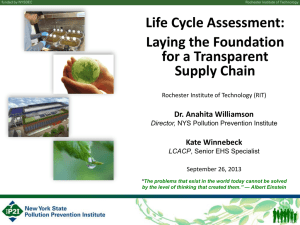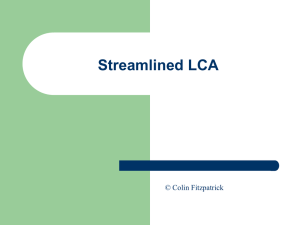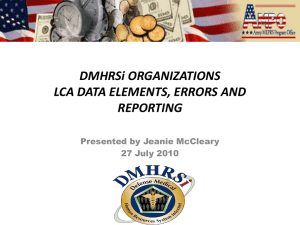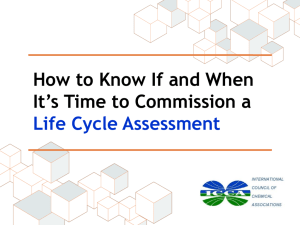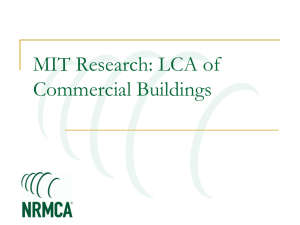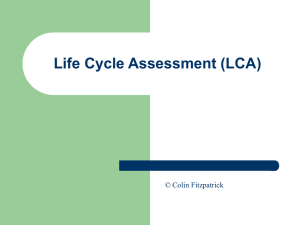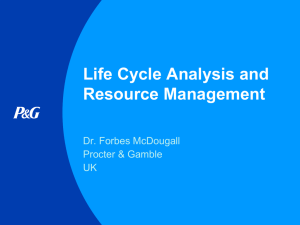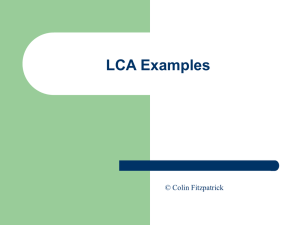PowerPoint - xs3d.kaist.edu
advertisement
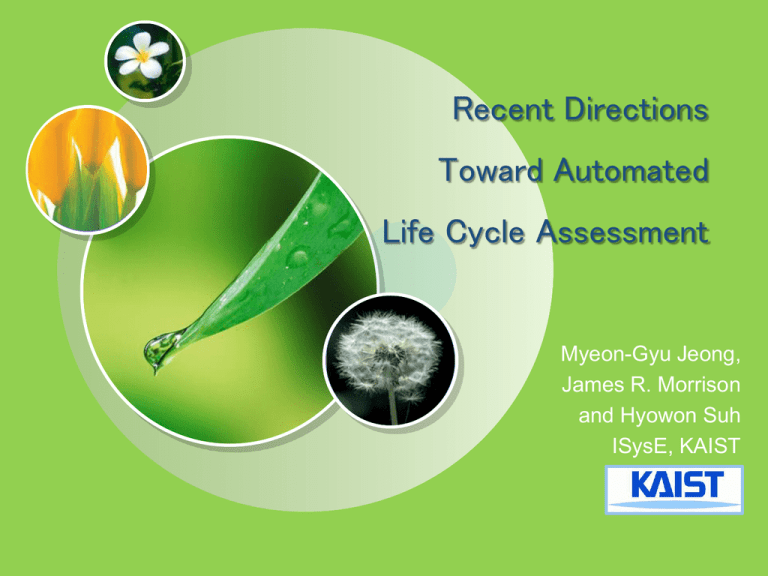
Recent Directions
Toward Automated
Life Cycle Assessment
Myeon-Gyu Jeong,
James R. Morrison
and Hyowon Suh
ISysE, KAIST
2
Presentation Overview
1. Introduction
2. LCA via CBR
3. Case study
4. Concepts for LCA at arbitrary levels of detail
5. Concluding remarks
2
1. Introduction
1.
2.
3.
4.
5.
Problem definition
Related work
Motivation
Research purpose and scope
Comparison to related work
3
4
1.1 Problem definition
Generic Product Development Process
Mission
Approval
Planning
Concept
review
Concept
development
System spec.
review
System-level
design
Critical design
review
Detail design
Production
approval
Testing and
refinement
Many Iteration Cycles for
Design Improvement
[Design] - known
[Manufacturing] - yet unknown
Define part geometry
Choose materials
Assign tolerances
Complete industrial design control doc.
Piece part production processes
Design tooling
Define quality assurance processes
Begin procurement of long-lead tooling
Input
Environmental Impact Evaluation
Life Cycle Assessment (LCA)
Preceding conditions for eco improvement
Initial Design
Standardized by ISO 14040~3 series
Improved Design
Production
ramp-up
5
1.1 Problem definition
Concept and General Procedure of Life Cycle Assessment
Goal Definition: which products or service are assessed? How to use the result of LCA?
Resources
Materials
Parts
Ass’y
Product
Use
Disposal
Incineration
Landfill
Scope definition
Life cycle stage
Unit process
Recycle & Reuse
Recycle
Emission to air
CO2
SOx
NOx
Inventory analysis
Measure envir. burden
Global warming
Impact analysis
Ozone layer depletion
Emission to water
T-N
T-P
metals
Acidification
Considerable time and money to
collect relevant data
Water pollution
Impact to nature and human
Interpretation
Review and reporting
Detection of important issue
Make report
Check the reliability of data
Critical review
6
1.1 Problem definition
Limitations of LCA
Collecting all relevant data and information throughout the entire life cycle at the detail design stage is impossible
No matter what data is available, it requires considerable time and money
In case of the product have short development cycle such as cellular phone, LCA put a burden on whole PDP
[Inventory Analysis]
Input 1, 2, …,n
Resources
output 1, 2, …,n
Input 1, 2, …,n
Materials
output 1, 2, …,n
Input 1, 2, …,n
Parts
output 1, 2, …,n
Input 1, 2, …,n
Assembly
output 1, 2, …,n
Input 1, 2, …,n
Product
output 1, 2, …,n
Input 1, 2, …,n
Use
output 1, 2, …,n
Input 1, 2, …,n
Disposal
output 1, 2, …,n
Streamlined LCA
is techniques that purposely adopt some sort of [simplified approach] to life cycle assessment
7
1.2 Related work
Three basic levels of LCA (Wenzel 1998)
LCA scoping
Matrix LCA
Life cycle stage
Environmental category
Scoring
based on checklist
[Input]
[Output]
Material,
Energy
Material
(Acquisition)
Air, Water,
Waste
Material,
Energy
Manufacture
Air, Water,
Waste
Material,
Energy
Use
Air, Water,
Waste
Material,
Energy
Disposal
Air, Water,
Waste
Product Attribute
+
Existing Full LCA results
Learning/Fitting
Product Attributes
Numerical LCA
BLACK BOX
(Numerical &Statistical)
Compare results
Matrix Operation
(Weighting, Sum.)
Environmental Impact
Results
Results
(Omit indifferent process or in/output)
Suggested by
Graedel & Allenby(1995), Pommer(2001)
Christiansen, K.(1997), Hur, T.(2003)
Ines Sousa(2000), Seo, K.K(2006)
No systematic procedure to select life-stage
and part/module of product
Hard to learning or fitting the black box and
applicable to only specific product category
& environmental stressor
Limitations
Only qualitative assessment and
low accuracy of result
8
1.3 Motivation
In general, most enterprises develop new products by revising or
reusing the similar previous product,
Power train
Interior Electrics
Power train
Interior Electrics
If we collect the LCA result of previous product, then we can
estimate the LCA of new product from previous cases
LCA result for regulation, certification
Complicated LCA process
Design output
LCA result
Case based reasoning for LCA
Case retrieval
Seat
Engine
Adaptation
Battery
Brake module
9
1.4 Research purpose and scope
Generic Product Development Process
Many Iteration Cycles
Mission
Approval
Planning
Concept
review
Concept
development
System spec.
review
System-level
design
Critical design
review
Testing and
refinement
Detail design
Production
approval
Production
ramp-up
Design for Environment
Support
Case representation
- FBSE expressions
- Relations
Case indexing
- Case clustering by k-medoids
CBR for LCA
Case retrieval & selection
- Similarity measurement
and computation
Case adaptation
- Geometry attribute based linear
modeling algorithm
- Multi-regression analysis
10
1.5 Comparison to related work
Standard LCA
LCA scoping
Matrix based
Substitution of
LCI DB
Proposed
method
Precision
High
Medium
Low
Medium
Medium-High
Key technique
Allocation, mass
balance models
ANN models
CBR, FBSE,
Regression
Data type
Quantitative
Quantitative
Qualitative/
Quantitative
Quantitative
Quantitative
Utilization of LCI
DB
Yes
Yes
None
Yes
None
Modeling effort
required
High
Medium
Low
High
Medium
Required
Resource
Highest
High
Low
Medium
Medium
Intended user
Environmental
expert
Environmental
expert
Product designer
Environmental
expert
Product designer
Applicable to
enterprise
Low
Medium
High
Medium
High
Allocation, mass Checklist based
balance,
quality
empirical models
assessment
2. LCA via CBR
1.
2.
3.
4.
5.
6.
Overview of the method
An FBSe representation
Similarity measure
Case indexing
Case retrieval and selection
Case adaptation
11
12
2.1 Overview of the method
Similarity measure
New problem w/o LCA
Legend
Flow
Consider
Function similarity
Product/part
specification
FBS
modeling
Weighting
Function
decomposition
Behavior similarity
Structure
(Non-numeric)
Structure
(Numeric)
Similarity sum
Find
similar cluster
Retrieve close
case set to P
Construct
new cluster set
Case adaptation
Select Adaptation attribute
Preprocessing area
Case building
Case
formulation
Old case w/ LCA
Function
decomposition
Product/part
specification
LCA result
FBSE
modeling
Clustering
(k-medoid)
Regression modeling
Find optimal solution set
Apply solution set to N
Save as new case
Estimated
LCA result
13
2.2 An FBSE representation
[New FBSE model]
[Function-Behavior-State(structure) model]
Solution space
Problem space
by Umeda
Function: The purpose of the design
(e.g. the purpose of a fan is to move the air)
Behavior: The principle used to achieve the function
(e.g. propeller fan is a kind of fan to move the air)
Structure: The physical characteristics of the component
(e.g. geometry size, material, color)
Environmental impact: The component effect in the eleven eco-indicator 99 categories
(e.g. climate change, ozone layer)
[Example of FBSE expression]
Two shafts have same geometry and material
Fan
Function
To move the air
Behavior
Cross flow type
Structure
Number of blade: 20
Diameter: 50mm
Length: 230mm
…
T1
F
A
Environmental
impact
Climate change: 0.0252Pt
Radiation: 0.324mPt
…
T2
B
To support load
To transfer torque
No input at “Use” stage
Require lubricant at “Use” stage
Different LCA result
14
2.2 An FBSE representation
uctural 1
1
A (1,n)
1
A (2,n)
1
A (3,n)
1
A (m,n)
uctural 3
3
A (1,n)
3
A (m,n)
. effect
eA
s1A (m,1)
s1A (m,2)
Function
(material)
(galvanized),(sheet),(steel)
fA
(color)
(silver)
(surface),(treatment)
(powder),(coating)
…
…
s3A (m,1)
s3A (m,2)
s3A (m,3)
(revolution),(speed)
500.0
2250.0
…
…
…
Behavior
Structure
w1
…
w2
…
w3
w
𝑏A1
(cross) (flow) (fan) …
𝑏A2
(single) (type)
…
Environmental
effect
R1 (carcinogens) … R11 (fossil fuels)
(move) (a
…
Function
Behavior
Fv
…
…
…
…
Structural 2
s2A (m,1)
s2A (m
s2A (1,n)
(mass)
22
L
P
1 (raw material acquisition)
…
…
…
…
s2A (2,n)
(wheel), (diameter)
80
2 (part manufacturing
process)
(cutting),(by),(milling)
0.00525
…
0.00286
s2A (3,n)
(length)
23
(assembly),(by),(rolling)
0.00422
…
0.00247
s2A (4,n)
(number),(of),(blades)
26
…
…
…
…
…
s2A (5,n)
(number),(of),(plates)
4
6 (Disposal)
…
…
…
…
s2A (m,n)
…
…
15
2.3 Similarity measure
Attribute type
Layer
Modeling language
Function Attribute
Functional basis by Hirtz et al., at NIST
Similarity Measure function
Tracing the degree of kinship from
hierarchical function structure
Function (f) consist of pairs of words: function verb (Fv) and function object (Fo)
Ex) ((move), (air))
Nonnumerical value type
Behavior Attribute
Standard or general engineering terminology
Cosine similarity
Behavior (b) consists of up to 32 phrases
Ex) ((cross, flow, fan))
Point matching function
Structure Attribute
Product specifications or BOM terminology
Structures consist of three parts S=S1×S2×S3
Numerical value type
S1 is a set of two phrase vectors used for nonnumeric descriptions
Ex) ((material), ((galvanized), (sheet), (steel)))
S2 is a set of vectors, each consisting of a phrase and a real number
Ex) ((mass), 220)
S3 is a set of vectors, each consisting of a phrase and two real numbers
Ex) (((revolution), (speed)), 500.0, 2250.0)
Environmental
effect
Eco-indicator 99 method
The environmental effect eE := L×P32×R11
L is the the set of life cycle stage
Interval matching function
16
2.3 Similarity measure
4. Structure similarity
a) Two phrase vectors used for nonnumeric descriptions
1. Function verb similarity
1
U vf c A , cB :
1
K K Bv
v
A
K Av K Bv
U c A , cB :
u f i,1 , f j,1 ,
i 1 j 1
f
v
A
1
U cA , cB : o o
K A KB
U1
A
K K
u s i, 2 , s j, 2 I s i,1 , s j,1 ,
U1
i 1 j 1
B
1
A
1
B
u f i, 2 , f j, 2 ,
w
A
B
1
1
U 2 c A , cB :
2
2
2
2
s
i
,
2
s
j
,
2
A
B
,
I s A2 i,1 , sB2 j ,1 1
2
2
c
s
i
,1
c
s
i
,1
i 1 j 1
max A min A
2
K UA
U2
A
K K BU
2
2
KU
B
cmax sA2 i,1 : max max sc2 j, 2 I sA2 i,1 , sc2 j,1
cM
1
U cA , cB : b b
K A KB
1
B
b) Structural descriptions with real number values
3. Behavior similarity
b
1
A
p
Where, the indicator function I(x, y) = 1, if x=y, and 0, otherwise.
K Ao K Bo
i 1 j 1
1
B
2. Function object similarity
f
o
K UA K U
B
1
1
j 1, ,32
K Ab K Bb
u b i,1 , b j,1 ,
i 1 j 1
p
A
B
c) The set of vectors, each consisting of a phrase and two real numbers
s 3A i,3 sB3 j , 2
3
3
3
3
I
s
i
,1
,
s
j
,1
I
s
j
,
2
,
s
i
,3
A B 2 B A s3 j,3 s3 i, 2 ,
i 1 j 1
A
B
3
U
5. Overall similarity measure
3
cA , cB :
K UA K U
B
1
3
K UA K BU
3
3
Where, I2(x, y) = 1, if x < y, and 0, otherwise
U c A , cB : wvf U vf c A , cB wof U of c A , cB U b c A , cB wU U 1 c A , cB wU U 2 c A , cB wU U 3 c A , cB .
Here, wvf wof 1 and wU wU wU 1
1
2
3
1
2
3
17
2.4 Case indexing
Clustering cases with representative case (𝑣𝑡 ) as the center
C2
c5
c1
c3
k-medoids
clustering*
c4
c2
c7
c6
c5
c1
c8
𝑣2
C1
c4
c2
r2
c8
𝑣1
c6
c3
r1
c7
𝑣𝑡 ≡ arg min.
dist(𝑐𝑎 , 𝑐𝑏 ) 𝑐𝑎 ∈ 𝐶𝑡
𝑐𝑏 ∈𝑐𝑡
dist 𝑐𝑎 , 𝑐𝑏 = 1 −
1
𝑛
𝑛
𝑖=1 𝑤𝑖 𝑖=1
𝑤𝑖 × sim(𝑓𝑖𝑎 , 𝑓𝑖𝑏 )
where, 𝑓𝑖𝑎 is attribute set of case a
and 𝑓𝑖𝑏 is attribute set of case b
𝐶𝑡 = 𝑐1 , 𝑐2 , ⋯ , 𝑐𝑖−1 , 𝑐𝑖 , ⋯ 𝑐𝑛 dist(𝑐𝑖−1 , 𝑣𝑡 ) ≤ dist(𝑐𝑖 , 𝑣𝑡
𝑟𝑡 = max. dist(𝑐𝑖 , 𝑣𝑡 ) 𝑐𝑖 ∈ 𝐶𝑡
In out study, each indexing layer(FBS) have different data type, and some of them have nonnumeric value.
In contrast to the k-means algorithm, k-medoids chooses single case as center.
By introducing clustering k-medoids algorithm, we can grouping some similar cases with representative case 𝑣𝑡 as the center, and
indexing the rest cases according to distance with 𝑣𝑡
18
2.5 Case retrieval and selection
Case memory
C2
This area is
C1
r1
c6
c5
(v1)
c5
𝑈 𝑣1 , 𝑁 − 𝑟
c4
c2
c3
c2
c3
(v2)
C3
𝐶
c7
N
c5
c7
𝑁
r3
c4
c6
c1
c1
r2
c4
𝐶𝑃𝑟
c2
c3
(v3)
c6
c1
c7
r
Case clustering
Similarity metric: 𝑈 c𝐴 , c𝐵 , and k-medoids clustering algorithm
Retrieve cluster
CR
𝐶
𝑁
c7
N
r
c3
:= {cCi: i=arg maxj U(𝑣𝑗 ,N)}
Selected case set
CN
:= {ciCR: U(ci,N) ≤ r}
c6
Filtering by life cycle stage (l) and unit process (p)
p
𝐶 𝑁 (l, p) ≔ c𝑖 ∈ 𝐶 𝑁 : e𝑖 l, m = p for some 𝑚
Final adaptation case set
𝐶 𝑁 (l, p)
19
2.6 Case adaptation
𝐶𝑁
c7
N
r
c3
For case t(j)
s2t(1) (m,1)
s2t(1) (m,2)
For N
s2N (m,1)
s2N (m,2)
s2t(1) (1,n)
(mass)
220
s2N (1,n)
(mass)
180
s2t(1) (2,n)
(wheel), (diameter)
80
s2N (2,n)
(length)
145
s2t(1) (3,n)
(length)
230
s2N (3,n)
(number),(of),(blades)
26
Where, t(j) is the original case index
c6
ct(j)CN(l,p)
Basis for linear regression
zt(j) contains 11 real
numbers for the ecological
effects of that case for life
cycle l and unit process p.
𝑥 2,𝑁 (m,1)
2,𝑁
𝑦𝑡(1)
(m,2)
𝑦𝑁2,𝑁 (m,2)
s2N (1,n)
(length)
230
145
s2N (2,n)
(mass)
220
180
Each row of E contains
the 11 errors for the
eco-impact categories
for a particular case
Ω10 ⋯ Ω11
2,𝑁
2,𝑁
0
𝑧𝑡 1
𝑦
𝑦
𝜀1
1 𝑡 1 ,1 ⋯ 𝑡 1 ,𝐾𝑅
1
11
Ω
⋯
Ω
1
1
⋮ ,𝑌 = ⋮
⋱
𝑍=
,Ω=
,𝐸 = ⋮ .
⋮
⋮
⋮
⋱
⋮
2,𝑁
2,𝑁
𝑧𝑡 𝑀
𝜀𝑀
1 𝑦𝑡 𝑀 ,1 ⋯ 𝑦𝑡 𝑀 ,𝐾
𝑅
Ω1𝐾𝑅 ⋯ Ω11
𝐾𝑅
𝑍 ∈ R𝑀×11 , the matrix of
observed ecological effects
for M cases in CN(l,p)
𝑌 ∈ R𝑀×(𝐾𝑅 +1) ,
KR is the number of
non-null phrases
Ω ∈ R(𝐾𝑅 +1)×11 is our
decision variables (or
independent variables)
𝐸 ∈ R𝑀×11 be our matrix of
regression errors (residues)
By least square error minimization, optimal decision variable values will be:
Ω = 𝑌𝑇 𝑌
−1 𝑇
𝑌 𝑍
The estimated ecological effect row vector zNR1×11 for new product module N in the life cycle stage l for unit process p is:
𝑧𝑁 = 1
2,𝑁
𝑦𝑁,1
2,𝑁
⋯ 𝑦𝑁,𝐾
Ω
𝑅
3. Case study
1. Outline of case study
2. Case memory organization by k-medoids clustering
3. Case adaptation and results
1. Case scenario 1
2. Case scenario 2
20
21
3.1 Outline of case study
Target item
New problem P: Cross flow fan in vehicle air purifier
Plate
Rolled aluminum
(0.6T)
Blade
Rolled aluminum
(0.2T)
Simple Specifications
Material
Mass (g)
123
Wheel diameter (mm)
60
Length (mm)
230
No. of blade
26
No of plate
4
Max. RPM
2000
Impeller profile
Cross flow
Flow type
Single
Goal definition
Estimate eco impact values of cross flow fan of vehicle air purifier
Intended user: design engineer
Scope definition
Interested area is from raw material acquisition to part assembly (Upstream process)
Raw material acquisition
Part manufacturing
Interested Area
Ass’y
Transportation
Use
Disposal
22
3.2 Case memory organization by k-medoids
clustering Environmental impact
was evaluated by SimaPro 7 (Commercial SW)
[Case memory of fan]
Classification of
Impeller(blade) profile
Centrifugal
Axial flow
Backward vaned
Backward
curved
Forward vaned
Backward
inclined
Strip
Single
Propeller
Tablock
(Fergas)
Double
Single
Cross flow
Mixed flow
13
2
Tubeaxial
33
3
Double
4
15
Case scenario 1
Total 100 cases were collected
10
10
5
5
Case memory
C1
C2
C3
C4
C5
N
Distance of P of each cluster medoid
CR = C2 :={50,51,52,53,54,55,56,57,58,59,60,61}
CN :={50,52,54,56,58,}
Cluster No.
1
2
3
4
5
Medoid No.
97
61
41
22
68
Distance
0.8199
0.0153
0.1746
0.2601
0.6084
Case scenario 2
Cluster 2 is the closest cluster to P
Case memory
C1
C3
C4
C5
N
CR = C3 = CN :={30,31,32,33,35,36,37,39,40,41,43,45,47,48,49}
CN(2,((cutting),(by),(milling))) :={31,32,33,36,39,41,47,49}
CN(2,((assembly),(by),(rolling))) :={30,37,35,40,43,45,48}
23
3.3 Case adaptation and results
– Case scenario 1
0.30
0.25
Manufacturing Process - Cutting
Real
Estimated
Manufacturing Process - Assembly
0.14
0.12
0.10
0.20
0.15
Pt
Pt
0.08
0.06
0.10
0.04
0.05
0.00
0.02
0.00
Real
Estimated
24
3.3 Case adaptation and results
– Case scenario 1
3.5%
Cutting
Assembly
3.0%
2.5%
Estimation Error
Avg 2.56%
2.0%
1.5%
2.63%
2.21% 2.20% 2.23% 2.14% 1.99%
2.19% 2.18% 2.27% 2.32% 2.09%
1.0%
0.5%
0.0%
0.32% 0.30% 0.31% 0.35% 0.41% 0.37% 0.33% 0.33% 0.30% 0.27% 0.37%
25
3.3 Case adaptation and results
– Case scenario 2
Manufacturing Process - Cutting
0.35
Real
Manufacturing Process - Assembly
Estimated
0.14
0.12
0.25
0.10
0.20
0.08
Pt
Pt
0.30
0.15
0.06
0.10
0.04
0.05
0.02
0.00
0.00
Real
Estimated
26
3.3 Case adaptation and results
– Case scenario 2
8.0%
Cutting
Assembly
7.0%
Avg 6.88%
Estimation error
6.0%
5.0%
4.0%
6.61%
4.85%
6.20% 5.97% 5.57% 5.36% 6.03% 6.00% 6.25% 6.39% 5.77%
3.0%
2.0%
1.0%
0.0%
0.85% 1.15% 0.84% 1.14% 1.22% 1.13% 0.89% 0.91% 0.82% 0.76% 1.02%
4. Concepts for LCA at arbitrary
levels of detail
27
28
4.
4. Concepts for LCA at
arbitrary levels of detail
Product A
FA
𝐹𝐴1 ⊇ 𝐹𝐴3 , 𝐹𝐴4
𝐹𝐴1 = {𝐹𝐴3 , 𝐹𝐴4 }
Sub-product A1
FA1
Sub-product A2
FA2
The function of sub-product(FA1) is comprised of functions of component(FA3, FA4)
For example, {(move), (air)} and {(rotate), (fan)} is subset of {(make), (wind)}.
Only leaf nodes of hierarchy have behavior, structure and environmental effect description,
Component A3
Component A4
Component A5
Component A6
FA3, BA3, SA3
FA4, BA4, SA4
FA5, BA5, SA5
FA6, BA6, SA6
because leaf nodes indicate single component has detailed behavioral and structural attributes.
And FBSE attribute is subordinate to upper node.
Electric fan
{(make), (wind)}
Therefore, we can describe BA1 with BA3 and BA4.
However, if the function of new problem N is not fully decomposed, we can not search the
environmental effect from lower level, because there are no B, S information.
Under these situation, construction the generalized functional hierarchy for specific product family
will gives some help to find anticipated sub functions and associated environmental effect.
In other words, with these generalized functional hierarchy, we can anticipate and support the
design process with only high level functional attribute.
The figures in next pages show these concepts.
Fan
{(move), (air)}
Motor
{(rotate), (fan)}
29
4.
4. Concepts for LCA at
arbitrary levels of detail
Old case A
Sub-product A1
FA1
Old case B
Product B
FB
Product A
FA
Sub-product B1
Sub-product A2
FA2
FB1, BB1, SB1, EB1
Sub-product B2
FB2
Component A3
Component A4
Component A5
Component A6
Component B3
Component B4
FA3, BA3, SA3, EA3
FA4, BA4, SA4, EA4
FA5, BA5, SA5, EA5
FA6, BA6, SA6, EA6
FB3, BB3, SB3, EB3
FB4, BB4, SB4, EB4
B1 is instance of C6
A4 is instance of C4
Model C is the generalized
functional hierarchy for specific
product family
Model C
FC
Case memory
Sub-model C1
FA1
Sub-model C2
FA2
A3 is instance of C3
Sub-model C3
Sub-model C4
FA3, BA3, SA3, EA3
FA4, BA4, SA4, EA4
cases
cases
cases
cases
cases
cases
Sub-model C5
FA5
Sub-model C7
Sub-model C8
FA5, BA5, SA5, EA5
FA6, BA6, SA6, EA6
cases
cases
cases
cases
cases
cases
Sub-model C6
FA6, BA6, SA6, EA6
cases
cases
cases
B4 is instance of C8
30
4.
4. Concepts for LCA at
arbitrary levels of detail
If the function of product N is not fully decomposed,
we cannot estimate the E of N1, N2 and N5.
Model C
FC
Product N
FN
Sub-model C1
FA1
Sub-model C2
FA2
Sub-product N1
FN1
Sub-model C3
Sub-model C4
FA3, BA3, SA3, EA3
FA4, BA4, SA4, EA4
cases
cases
cases
cases
cases
cases
Sub-model C5
FA5
Sub-model C7
Sub-model C8
FA5, BA5, SA5, EA5
FA6, BA6, SA6, EA6
cases
cases
cases
Sub-product N2
FN2
Sub-model C6
FA6, BA6, SA6, EA6
Component C3
Component C4 Sub-product N5 Component c6
FN3, BN3, SN3, EN3
FN4, BN4, SN4, EN4
FN5
FN6, BN6, SN6, EN6
cases
cases
cases
cases
cases
cases
However, if the product N is subset of Model C,
C3, C4, C6, C7 and C8 will be anticipated lower function.
After confirm the sub functions and associated behavior, structure,
finally we can estimate environmental effect with LCA via CBR process.
Component C7
Component C8
FN5, BN5, SN5, EN5
FN6, BN6, SN6, EN6
5. Concluding remarks
31
32
Concluding remarks
1. Introduction
2. LCA via CBR
3. Case study
4. Concepts for LCA at arbitrary levels of detail
32
Appendix
33
34
* Functional basis reconciled function
set
Correspondents
Tertiary
Secondary
Isolate, sever, disjoin
Detach, isolate, release, sort, split,
disconnect, subtract
(1,1,1)
Divide
Refine, filter, purity, percolate,
strain, clear
(1,1,2)
Extract
Cut, drill, lathe, polish, sand
Primary
Primary
Secondary
Separate
Branch
(1,0,0)
Control
Magnitude
Actuate
(1,1,0)
(6,0,0)
Regulate
(6,14,0)
(1,2,0)
(2,3,0)
Import
Channel
Change
Dispose, eject, emit, empty, remove, destroy, eliminate
(2,4,0)
Export
(2,0,0)
(6,15,0)
Carry, deliver
Transfer
Control, equalize, limit, maintain
(6,14,11)
Increase
Allow, open
(2,5,4)
Transport
Conduct, convey
(2,5,5)
Transmit
Guide
Move, relocate
(2,6,0)
Translate
(2,6,7)
Increment (6,15,13) Amplify, enhance, magnify, multiply
Condition
(0,0,0)
Rotate
Assemble, fasten
(3,7,9) Join
Attach
(3,7,10) Link
Couple
connect
(3,7,0)
(3,0,0)
(6,16,17)
Prevent
Provision
Store
(7,0,0)
(7,17,0)
Contain
(7,18,0)
Collect
(6,16,18)
Steady
(4,9,0) Stabilize
Constrain, hold, place, fix
(4,10,0)
Align, locate, orient
(4,11,0) Position
Condense, create, decode, differentiate, digitize, encode,
evaporate, generate, integrate, liquefy, process, solidify, (5,12,0)
transform
Secure
Convert
Signal
Sense
(8,0,0)
(8,19,0)
Support
(7,17,20)
Shield, insulate, protect, resist
Capture, enclose
Absorb, consume, fill, reserve
Feel, determine
(8,19,21)
Detect
Indicate
(8,19,22)
Discern, perceive, recognize
Identify, locate
Announce, show, denote, record, register
(8,20,0)
Track
Convert
(8,21,0)
Display
(5,0,0)
Process
* Reference: NIST Technical Note 1447 “A Functional Basis for Engineering Design: Reconciling and Evolving Previous Efforts”
Disable, turn-off
Provide, replenish, retrieve
Measure
(4,0,0)
Prepare, adapt, treat
Accumulate
(7,17,19)
Supply
(3,8,0) Mix
Attenuate, dampen, reduce
Compact, compress, crush, pierce,
deform ,form
End, halt, pause, interrupt, restrain
Inhibit
Associate, connect
(6,15,16)
Stop
(6,16,0)
Allow DOF
(6,15,14)
(6,15,15)
Shape
Functional
basis
Direct, shift, steer, straighten, switch
(2,6,6)
Close, delay, interrupt
Adjust, modulate, clear, demodulate, invert, normalize,
rectify, reset, scale, vary, modify
Decrement
(2,5,0)
Advance, lift, move
Add, blend, coalesce, combine, pack
Enable, initiate, start, turn-on
Distribute
Form entrance, allow, input, capture
(2,6,8)
(6,13,0)
Decrease (6,14,12)
Diffuse, dispel, disperse, dissipate, diverge, scatter
Constrain, unfasten, unlock
Correspondents
Remove
(1,1,3)
Spin, turn
Tertiary
(8,20,23)
(8,20,24)
Mark, time
Emit, expose, select
Compare, calculate, check
35
*k-medoids clustering algorithm
The k-medoids algorithm is a clustering algorithm related to the k-means algorithm and the medoid shift algorithm. In contrast to the
k-means algorithm, k-medoids chooses data points as centers (medoids or exemplars).
1. Arbitrary select k of the n data
points as the medoids
2. Associate each data point to
the closest medoid, and calculate
total cost of each cluster
3. Swapping medoid and random
case, and calculate total cost
4. Finalized cluster set
In our research, similarity measurement can be defined as the sum of functional distance, behavioral distance and structural distance.
However each indexing layer have different data type, and some of them have nonnumeric value.
Therefore, k-medoids clustering algorithm is appropriate to us than k-means.
